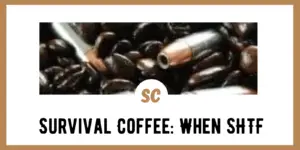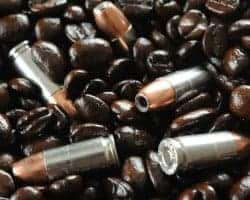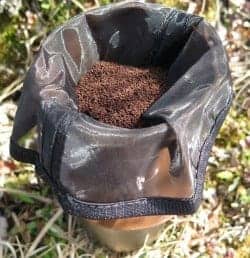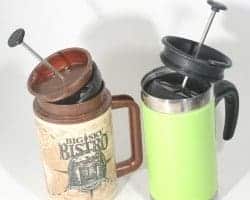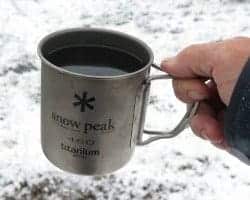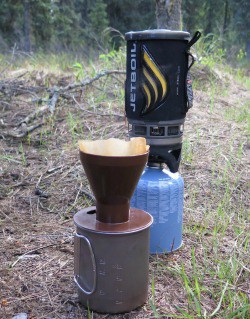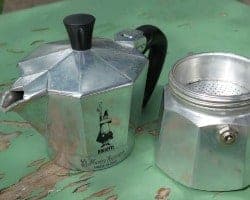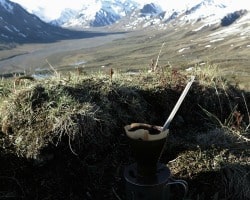Every morning, I take the pulse of the planet by brewing a cup of coffee. As the second most traded commodity on earth, and the number one imported food item in the United States, coffee is a major indicator of how smoothly the world is turning. Any hints of social collapse will hit coffee faster than either gold or silver, and only oil is traded more heavily than those precious caffeinated beans.
In this article, we’ll be talking about:
- Coffee and its importance when SHTF
- Different ways to prepare coffee, no matter where you are
SKIP AHEAD
A Brief History
The National Coffee Association suggests there might be some truth in the legend that coffee was discovered in the Ethiopian highlands during the ninth century by a goat herder who noticed that his animals did not sleep well after eating the seeds of a particular plant.
After some human experimentation with the beans, coffee as we know it was born. By 600 years ago, it was off and running as a preferred beverage across the Middle East. Today it is keeping humans up at night all over the world.
Most Recommended Emergency Coffee
Stockpiling coffee is crucial. We recommend the product below:
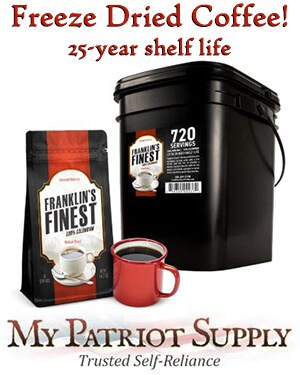 |
|
Check Price on MyPatriotSupply
|
Coffee and Guns
Although coffee is a global phenomenon, the only US state that grows coffee is Hawaii. But when the SHTF, as the saying goes, you can’t get there from here, so your survival coffee supply is all there is.
Cup of Joe
Coffee has always been an important barter item, and its post-collapse value will skyrocket (along with numerous luxuries). Coffee and conflict go hand-in-hand. GI Joe, as in “Cup of Joe” experienced the importance of coffee as a ration during wartime. Tea may have launched this country, but coffee and bullets keep it free!
Rarely does a daily hunt begin without a coffee ritual of some sort. Whether drinking “vitamin C” in a small town cafe or pouring the black gold from a thermos in a duck hunting blind, coffee and guns are inseparable. So, when society takes a wrong turn and you don’t know who to trust, your emergency survival coffee will still be your friend.
Standing Your Grounds
The point of grinding coffee beans is to break open the bean exposing the flavorful roasted meat inside the seed, and increase the bean’s surface area that can directly contact hot water. To grind coffee, all you need are coffee beans, and something harder than the beans.
Hand Grinder
Kitchen or home-sized grain mills will make short order of coffee beans, but more than a few of the prepared folks I know have a hand grinder in the house, whether in storage or on display as an antique. Hand grinders are like giant pepper mills, which, by the way, can also be coaxed into service as coffee grinders depending on their size and capacity.
The best option is to get a modern hand grinder of which there are so many available that I cannot help but wonder if the manufacturers know something about the future that I don’t. For the long haul, I’d recommend one of the nicer modern stainless steel grinders rather than either a retro-looking one or a grinder with any part made of glass.
Stone Grinding Coffee Beans
A mortar and pestle does a fine job of grinding up beans. Another method is similar to the maze (corn) grinding tools of the ancients. The mano, or hand grinder, is a rock with a depression like a bowl in it whereby another smaller rock is used to crush or grind the material placed in the bowl.
Rolling Pin
Rolling pins also pulverize coffee beans when the two come in contact. Hardly a new idea since stone rolling pins are as ancient as the mano. And if you have plenty of time on your hands, or some children that need a diversion, imagine all the post-apocalyptic fun you can have crushing individual coffee beans with pliers.
Making Coffee
Once you have the fresh grounds, the next step, and the only other step is to make some delicious coffee. Here are several ways to take that next step, some more refined than others, but all are effective and well-tested.
Steeped Coffee
Steeping coffee is a variant of cooking coffee, and is simply letting the coffee grounds sit in hot water for a while. The French Press is a popular coffee-cooking method, but the familiar glass cylinder and the matching plunger are hardly necessary. Any pot, cup, or tin will work fine.
Some outdoor companies are manufacturing combination French Press/coffee mugs where prior to drinking, the plunger handle is depressed forcing all the grounds to the bottom of the mug.
A Word of Caution
Two cautions from experience; first, the filter is about 90% effective meaning a toothy grin while drinking from a “Big Sky Bistro” will likely produce some laughter by those viewing the black grounds wedged in your teeth.
And second, there will be an impressive pile of sludge at the bottom of your cup from which you can still drink. But don’t. It is nothing more than expended coffee syrup and will provide a rather tragic end to your drinking bliss.
Cowboy Coffee
Another popular variation of cooking coffee is referred to as “Cowboy Coffee.” This is simply boiled coffee and requires nothing more than the grounds to be boiled in water. Cowboy Coffee differs from steeped coffee in that steeping has hot water added to the ground coffee while away from the primary heat source.
Cowboy Coffee is the simplest preparation method, but not the best for flavor due to the higher temperature that the grounds are exposed to for a longer time. Of course, if you are up in the mountains, water boils at a lower temperature than at sea level so the damage to the taste of the coffee is less.
Keeping It Authentic
Authentic Cowboy Coffee is little more than a handful of grounds tossed into a pot of boiling water. Or worse, thrown into the pot prior to boiling. If you want the true experience of Cowboy Coffee, you can either drink the nectar, grounds, and all, or run the fluid through an old sock to strain out the grounds.
Add Just a Dash
The more refined among us might make their Cowboy Coffee by placing the grounds into the sock before dropping it in the pot, upping the macho factor. Since Cowboy Coffee is usually more bitter than other brewing methods, a dash of salt is often added to the pot to counteract the excess bitter-tasting compounds.
Filtered Brew
Pour-Over coffee, or filtering, requires a filter medium full of grounds, a container below the filter to capture the coffee, and hot water to pour over the grounds. With a little practice, the coffee flavor can be controlled, since the fluid flowing out of the filter will change over time as the bean’s essence is depleted.
A popular survival accessory is known as a “coffee sock.” Not to be confused with the actual stocking used in Cowboy Coffee, the coffee sock is more of a reusable cloth strainer with a handle.
Know Your Filters
A note of caution about filters is that the taste of the filter can overpower that of the coffee. If you use non-filter-specific paper for your filter, such as paper towels, the bleach taste of the paper can render the coffee undrinkable. But that, of course, depends on your level of desperation.
Filtered coffee is also trendy these days for health reasons. When brewed, coffee releases plenty of chemicals, some desired, some not. The longer the coffee sits in hot water, the more undesirable molecules leach from the beans into your brew of COF2E2.
Pressure Coffee
Espresso is the popular name for pressure-brewed coffee. The variations of Americano, Latte, and Cappuccino are just post-expresso alterations to the tiny cup of black gold squeezed from the beans by pressurized hot water. Although sounding somewhat complex, pressure-brewed coffee can be accomplished with remarkably simple devices.
Moka Pots, or stovetop espresso machines, are small two-piece pots where a water reservoir base is topped with a strainer full of tightly packed ground coffee.
How Moka Pots Work
A small pot is screwed tightly to the base, holding the complete assembly together. As the water in the reservoir reaches boiling temperature, it encounters the resistance of the compacted coffee.
The increased challenge posed by the coffee causes the water to heat beyond the traditional boiling point until the pressure is great enough to move through the grounds and up a tube to the top of the pot, where it then falls into the collection area of the pot.
Don’t DIY
The process happens fairly quickly once the boiling point is reached. Due to the extreme danger of placing what amounts to a coffee pot bomb on your stove, I recommend only professionally made pressure coffee makers with a pressure release valve on the reservoir. Fabricating your own post-apocalyptic stove top espresso machine out of car parts is just asking for trouble
The Grim Reality
Regardless of your brewing methods, you must have coffee beans to make coffee. In a post-collapse situation, coffee may be as powerful a barter item as ammo. However coffee does have a shelf-life and unless vacuum packed, it will absorb other flavors as well as lose its own.
Freeze-dried coffee will last quite a while as well, but in my opinion as a gift card-carrying coffee snob, things will have to really hit the fan before I’ll get excited about the freeze-dried stuff. (is there such a thing as the best instant coffee?)
Roast Your Own Green Coffee Beans

Now all this assumes you have roasted coffee beans in your possession. If you only have green (unroasted) coffee beans, you will need to roast them first. While more of an art than a procedure, roasting coffee beans can be done using simple tools. With little more than a camp stove and old-school stove-top popcorn maker, coffee beans can be roasted into drinkable condition.
Not Too Short, Not Too Long
Just don’t get your hopes up right away, as there are far more ways to destroy your beans than to roast them. Home roasting is best done outdoors due to the smoke, but remember, there are only two main roasting mistakes once you have the right temperature dialed in: not roasting long enough, and roasting for too long. Other than that, it’s just a game of getting it right for your taste.
One For The Road
Survival has both hard edges and soft ones. As has been discovered through countless investigations of who lives and who dies when the SHTF, a positive attitude plays as much a role as having the right equipment.
If one intends to live through the dark times, then one must learn to smell the roses though the smoke. If you don’t then you are already at a serious disadvantage. Instead, prepare to drink up and know when the world starts to crumble, you will preserve one of the finest aspects of modern society: the cup of coffee.
Make sure to check out MyPatriotSupply’s coffee stockpile product:
 |
|
Check Price on MyPatriotSupply
|
All Photos by Doc Montana


